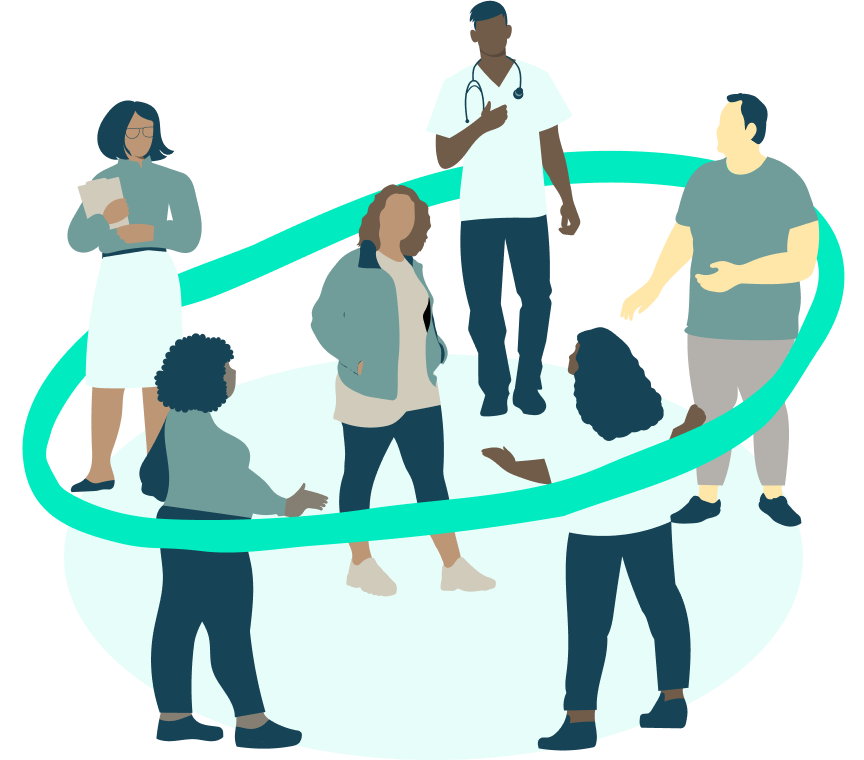The Binge-Restrict Cycle
While they may seem like polar opposites from one another, binge eating and restrictive eating are two sides of the same coin.
These behaviors often go hand-in-hand, with one fueling the other, in a pattern known as the binge-restrict cycle. The binge-restrict cycle is common and even normalized in our society (think about “saving up” calories for a big meal), but when it happens consistently, it can be a sign of an eating disorder—namely bulimia or binge eating disorder.
The binge-restrict cycle is difficult to stop on your own, but with the right support, you can break free. Read on to learn about the binge-restrict cycle, its various stages, and how Equip can help you break it.
What is the binge-restrict cycle?

The binge-restrict cycle refers to periods of restricted eating followed by episodes of binge eating. Restriction is when you ignore your body’s hunger cues and eat very little, or nothing at all. A binge is when you eat an objectively large amount of food in a short span of time, often past the point of fullness and with a sense of not having control.
The binge-restrict cycle is a natural consequence of not listening to your body’s needs. When you restrict food—either by not eating, eating very little, or not allowing yourself of the foods you really want—you deprive your body of the nutrients and energy it requires to function. Your body then tries to communicate to you that it needs nourishment. One of the ways it does this is by producing a hormone called ghrelin, known as the “hunger hormone,” which stimulates your appetite. As you continue to restrict, more ghrelin is produced, causing your hunger to grow to a point where it takes the wheel. When you look at it this way, binge eating is a natural evolutionary adaptation: your body thinks you’re starving, and so when it finally gets food, it tries to consume as much as it can.
But it’s not just that binges tend to inevitably follow periods of restriction; restriction can also be a common response to a binge. That’s because binges are almost always followed by intense feelings of guilt and shame (which can be compounded by diet culture messages that tell us that restriction is an accomplishment and eating is a failure), and these feelings can lead to more restriction. The restriction can serve to “make up for” the food eaten during the binge, or even as a self-imposed punishment for binge eating. Either way, the cycle continues.
Though the binge-restrict cycle most commonly shows up in binge eating disorder and bulimia, it’s also present in some forms of OSFED, and the anorexia binge-purge subtype.
The 4 stages of the binge-restrict cycle
There are four stages of the binge-restrict cycle. They all exist in relation to one another, with each stage fueling the one that follows and making it nearly impossible for you to establish normal, healthy eating habits without help.
Restriction
You restrict your food intake, which can take the form of fasting, skipping meals, avoiding certain foods or entire food groups, or eating much less than your body needs.
Craving
The restriction triggers intense cravings or extreme hunger.
Bingeing
Your hunger becomes too much to ignore, and you eat an excessive amount of food in a short period of time. This is your body’s attempt to make up for the earlier restriction.
Guilt
Once the binge is over, you experience intense feelings of guilt, shame, and other hard emotions. Those emotions then lead you to restrict yet again.
How to break the binge-restrict cycle
The binge-restrict cycle can make you feel like you’re stuck in a loop with no way out. But with proper treatment, you can stop the cycle in its tracks and work toward a future where you’re in control over what, and how much, food you eat.
Normalizing your eating habits is the first step toward treating any eating disorder or disordered behaviors, including the binge-restrict cycle. This generally means eating regular meals and snacks throughout the day, even if you’ve recently binged. By avoiding restriction, you can begin to dismantle the binge-restrict cycle. Eventually, the urge to binge and the binge behaviors will begin to weaken, and then disappear. An eating disorder-informed dietitian is a crucial support in helping you to make these changes and establish regular eating habits.
After you’ve made some progress toward normalizing your eating habits, it’s also important to tackle the mental and emotional factors that may be contributing to the binge-restrict cycle. Working with a therapist can be a game changer here. A therapist trained in treating disordered eating can help you understand the roots of your urges to binge, develop strategies for coping with potential binge triggers, and address the thought patterns that lead to restriction.

Therapeutic approaches used for binge-restrict cycles
Enhanced cognitive behavioral therapy (CBT-E)
Dialectical behavioral therapy (DBT)
Exposure and response prevention (ERP)
How Equip can help you break the binge-restrict cycle
Having an eating disorder can feel isolating, so our treatment is built to make sure that you feel supported as you work to break the binge-restrict cycle. We do this by matching you with a dedicated care team, as well as involving family, friends, and other supports in the treatment process.
When you begin treatment at Equip, here’s who you’ll be working with:
Therapist
Your therapist will guide you through evidence-based treatment modalities to unpack and process the mental and emotional components driving your behaviors.
Dietitian
Your dietitian will coach you through nutrition and strategic meal planning to make normalized eating habits easier to maintain.
Medical provider
Your medical provider monitors your weight and is there to help with any physical symptoms that arise as your body chemistry and your relationship with food and eating change.
Peer mentor
Each patient works one-on-one with a mentor who has made a full recovery from their eating disorder.
Family mentor
Each patient’s chosen support people will connect with another person who has supported a loved one through eating disorder recovery.
Recovery is possible
While the binge-restrict cycle looks similar from person to person, we know that each patient’s needs and challenges are unique. That’s why our providers pull from the leading evidence-based modalities to tailor treatment to you and work collaboratively with one another to ensure that you get the responsive, wraparound support you need.
Get in touch with our team today for more information or to schedule a free consultation.Get in touch with Equip

Privacy PolicyNotice of Privacy PracticesSecurity PolicyTerms & ConditionsGood Faith EstimateYour Privacy Choices
All names, likenesses, and identifying information have been changed in accordance with privacy laws. Images are of models, not actual patients.
Your privacy is Equip's priority, we safeguard your health information with end-to-end data encryption and industry-leading secure cloud practices. Our platform is HIPAA-compliant and SOC2 certified, ensuring your data is always protected.
